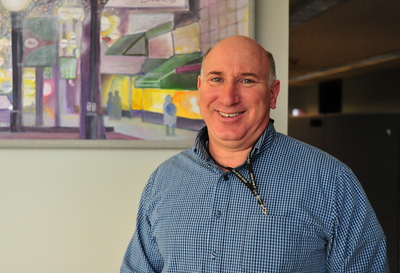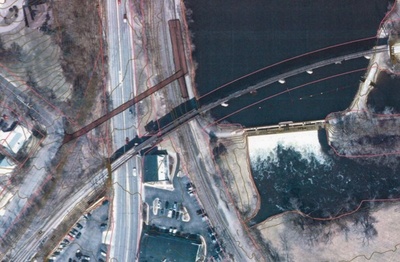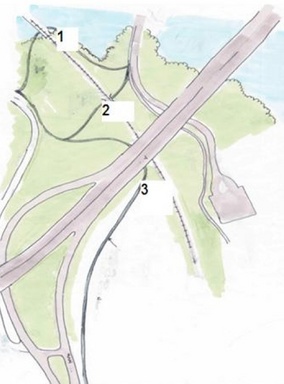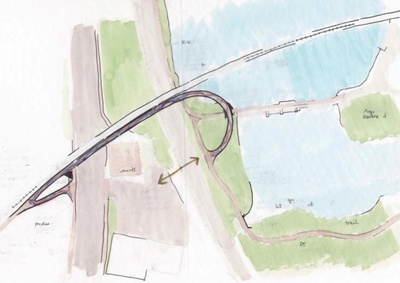Editor's note: This is Part 2 of a two-part Q&A with Eli Cooper, the city of Ann Arbor's transportation program manager. Read Part 1 here.
Whether it's adding more bicycle lanes to city streets, filling gaps in the city's sidewalk system or improving pedestrian crossings, you won't find Eli Cooper far behind.
In addition to his duties steering Ann Arbor's train station project, looking out for the city's interests in regional transit talks, and serving on the board of the Ann Arbor Transportation Authority, Cooper plays a role in the planning and implementation of just about all things transportation.
Cooper, the city's transportation program manager, sat down to speak with AnnArbor.com recently about improvements being discussed for the North Main Street corridor, where the next roundabouts might be in Ann Arbor, and other non-motorized transportation issues.
Clik here to view.

Eli Cooper, the city of Ann Arbor's transportation program manager, stands outside his office on a recent morning.
Ryan J. Stanton | AnnArbor.com
Cooper: The vision is to create a physical environment and a culture that embraces non-motorized transportation, so I think the metrics are malleable. You always want to do better than you're doing, and it's always good to have a target, but I think it's important that it's really the ethos of the community that people expect to see people walking and bicycling, and that more and more people choose to do so because the environment is attractive for those modes of transportation.
AnnArbor.com: You've studied mobility issues extensively throughout your career. When you look around the country, what are the places Ann Arbor should look to as guiding models?
Cooper: I like to think about places like Portland where you have a compact urban environment with a combination of all forms of mobility. That's a good example. I know the ones we typically target in terms of our metrics would be Madison and Boulder, other smaller-sized communities. It's interesting now to look at the larger cities — Chicago, New York, Denver, D.C. — where they have robust transit structures, where they have universal pedestrian accessibility and they've overlaid bicycling infrastructure. There really has been a movement in transportation to embrace active transportation, green transportation, sustainable transportation, and we have to look more carefully at the attributes of all-size communities to determine what might be the best fit for us.
Clik here to view.

Cooper recently presented this option for improved pedestrian safety and accessibility to the city's North Main task force. It shows a conceptual pedestrian bridge starting from Wildt Street and extending east over North Main Street and the railroad tracks and landing down at the Border-to-Border Trail next to Argo Pond. It's one of multiple options being considered by the city to increase connectivity between the east and west sides of Main Street and the railroad tracks near the Huron River.
City of Ann Arbor
Cooper: The cornerstone to all of the work is the embracing and the council adoption of the city's Non-Motorized Transportation Plan. We can look back to the '80s and the city had a bicycling plan. But in 2007, the adoption of the non-motorized plan was the first comprehensive look at the pedestrian environment, as well as the bicycling environment. And by adopting that at that moment in time, with the council having just prior to that created a funding stream for this, those two pieces together have really served to propel our non-motorized infrastructure forward.
The plan itself has created an opportunity for all of the city's transportation investments to appropriately include bicycle and pedestrian elements. I use Platt Road south of Packard as an example where we took a roadway that had some safety challenges as a four-lane facility, applied a three-lane cross-section, added bike lanes, pedestrian crossing. If you go out there now, you see people bicycling and walking. You didn't see that six years ago. What you saw was a four-lane road with people swerving to avoid cars making left turns.
AnnArbor.com: How far out is a bike-sharing program for Ann Arbor?
Cooper: It might be within 2013. I know that working with the Clean Energy Coalition, they've secured some capital dollars from the federal government to initiate a project. We're working through the details with a group of stakeholder partners, including the University of Michigan, the AATA, DDA staff, and there's still a gap to close in terms of the operating sustainability for the program. But I believe we have within our grasp the opportunity to see a project move forward yet this year.
AnnArbor.com: We've had some time to evaluate a handful of roundabouts in Ann Arbor and the surrounding area. Are they working out?
Clik here to view.

The city is considering options for a shared-use path connecting West Huron River Drive to the Border-to-Border Trail near Bandemer Park. No. 1 is a path under the railroad bridge, No. 2 is a path under the railroad, and No. 3 is a path under M-14.
City of Ann Arbor
I personally nominated the interchange area of Geddes and U.S. 23. It was an abysmal mess with traffic backing up. If you look at that interchange area now, compared to the way it functioned before the roundabouts were installed, it's a difference of night and day. And again, the issue there is primarily traffic flow. The piece that the citizens don't see — and this holds true for the 4-to-3 lane conversions as well as the roundabouts — is the reduction in severe crashes, so we're actually experiencing a safer transportation system as a result of roundabouts. I don't want to say they're the solution to every issue, because I remain concerned that under certain considerations and configurations, a roundabout does present challenges to pedestrian and bicycle activity.
AnnArbor.com: Where might we see roundabouts next?
Cooper: We've looked at the Fuller Road/East Medical Center Drive intersection, and we'll continue to evaluate how to properly accommodate the high pedestrian volumes with a potential roundabout. So it's still in the design world, but I think that's an area where it may be that we can design a roundabout with enough pedestrian accommodations that works for all.
The next one that we're going to see is State and Ellsworth. That's been funded and I think construction is going to start this year.
AnnArbor.com: Any others?
Cooper: I know as part of Miller/Newport we looked at one. There were some design challenges. I know staff is continuing to look at that.
AnnArbor.com: From a 'complete streets' standpoint, the North Main corridor is far from ideal. You've got pedestrians playing Frogger to get across the street. You've got bicyclists riding with fast-moving traffic that just came off a highway and no bike lanes. What's the solution there?
Clik here to view.

A conceptual shared-use bridge south of the Ann Arbor Railroad connecting the west side of Main Street with the Border-to-Border Trail near Argo Dam. Cooper recently presented this to the city's North Main task force.
City of Ann Arbor
You've seen the flashing beacons on Plymouth Road. You've seen the effect they can have with an appropriately designed crosswalk. We'll look at North Main and say, 'Well, down at Depot/Summit, we can improve those crosswalks and provide for a better pedestrian environment. What about further north of there?' The challenge is we don't have sidewalks on both sides of the roadway, so it's virtually impossible to say we're going to create a new mid-block crossing, because it's not crossing to anything on the west side. So there is some work needed to do something further north.
AnnArbor.com: What about the bicycling issues along there?
Cooper: That's a little more vexing. We do know that sidewalks can accommodate both pedestrians and bicyclists, and there is an almost complete sidewalk on the east side. There are a couple of areas down by the railroad tracks, and about two-thirds of the way north on the corridor, where there are some impediments that we're going to be looking at this coming year. There's what appears to be a drive ramp that goes to what appeared to have been at some point an access to an industrial property. But it precludes bicyclists comfortably using the corridor because you're basically at a roadblock, and so we're going to look at redesigning that and working through those issues.
What happens, though, when you get to the north end of the sidewalk today is it just ends. And the bicycling community has a desire to access West Huron River Drive, and so this is where options come in. One option is to attempt to design a transportation element — be it a crosswalk or something else, maybe even a roundabout. But I think there's a way to try to more effectively get cyclists from the sidewalk on the east side of the corridor to West Huron River Drive.
Set all that aside, there is currently a way that if you were to extend that sidewalk northerly to an area underneath M-14, there's a bridge that holds the highway up over the river and over the railroad, and there's space underneath that bridge. And the opportunity is to extend a path from the existing sidewalk northerly and use that grade-separated facility to create a safe, vehicle-free access to West Huron River Drive. This is not anything new. It's in the city's adopted Non-Motorized Transportation Plan, but with the emphasis of the North Main task force, we get to talk about it a little bit more.
AnnArbor.com: What's the latest thinking on implementing a so-called 'road diet' where the lanes of automobile traffic are reduced along North Main?
Cooper: That's what the non-motorized plan calls for today. Unfortunately the traffic volume and pattern won't support the same type of road diet that we've implemented in 10 other places in the city. What we've asked MDOT to consider is a variation on that theme, which is to take the current four-lane cross-section, reduce it to a three-lane cross-section. However, as opposed to having one lane in each direction with a center left-turn lane, instead look at using the center lane as a reversible managed lane, so that perhaps in the morning we could have two lanes serving inbound traffic, and in the afternoon peak have two lanes in the outbound direction.
And during the other periods, just have one lane in each direction with the space leftover being used for bicycle lanes. We don't know whether that's a feasible alternative from an engineering design standpoint, but I anticipate that MDOT or the city will take a closer look at that as they get closer to the project they have to reconstruct or rehabilitate that stretch of roadway.
AnnArbor.com: How seriously is the city looking at the idea of a pedestrian bridge going over North Main from the proposed greenway park site at 721 N. Main and connecting to the Border-to-Border Trail at Argo Park? What might that entail? What might that cost?
Cooper: We are serious in looking at it. Serious to the point where staff members have gone out and walked the corridor. We've drawn sketches. We've talked with bridge fabricators as to what a facility like that might cost. There has been and will continue to be emphasis on linking the proposed Allen Creek Greenway with the Border-to-Border Trail. The longer term might have grade-separated crossings over both Main Street and under the railroad or over the railroad.
If you were to look at Wildt Street, you can literally tie into the existing roadway there at grade, elevate across North Main, wind up 30 feet up in the air, but then you need to come back down. And in order to meet ADA standards, the amount of structure needed to ramp down is twice as long as the 300 or so feet to get from Wildt across the roadway, across the railroad, so the costs balloon quite quickly, and there are other considerations. But regardless of how you do it, we'll need to meet ADA requirements, and that is not inconsequential. The cost will run into the millions of dollars.
AnnArbor.com: Do the hundreds of millions of dollars being invested in high-speed rail improvements come into consideration when we're talking about these issues?
Cooper: We have an at-grade crossing at Lake Shore Drive. If that becomes threatened by the desire to have a fast train from Detroit to Chicago, the impacts on our city are real. And the city did send testimony to the Chicago-Detroit corridor planning process describing our concern about severing our at-grade crossings by instituting a higher-speed rail design in our city.
We believe, as a city that straddles the railroad, that safe passage from one side of the rail to the other has been ignored by the private railroads historically, and that if the public intends to make investments to increase the frequency and speed of trains in our community, then investments will need to be made to allow us to have the connectedness in Ann Arbor — not just connecting one side of the track to the other, but connecting our downtown to a prized, precious, natural-resource asset: the Huron River and the Border-to-Border Trail. As the state invests its hundreds of millions of dollars, we might find a way to create win-win solutions out of what's coming forward.
Ryan J. Stanton covers government and politics for AnnArbor.com. Reach him at ryanstanton@annarbor.com or 734-623-2529. You also can follow him on Twitter or subscribe to AnnArbor.com's email newsletters.